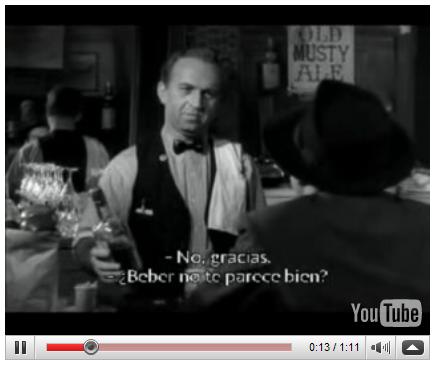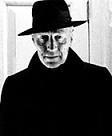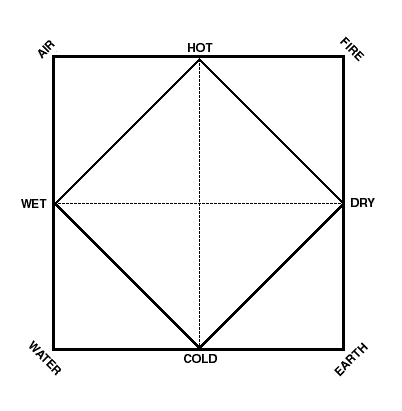Subtitle:
Tales of the Soul's
Conquest of Evil
Monday, June 30, 2008
Monday June 30, 2008
Sunday, June 29, 2008
Sunday June 29, 2008
Big Rock
"I'm going to hit this problem
with a big rock."
|
A professor discusses a poem by Wallace Stevens:
"Professor Eucalyptus in 'Ordinary Evening' XIV, for example, 'seeks/ God in the object itself,' but this quest culminates in his own choosing of 'the commodious adjective/ For what he sees… the description that makes it divinity, still speech… not grim/ Reality but reality grimly seen/ And spoken in paradisal parlance new'…."
– Douglas Mao, Solid Objects:Modernism and the Test of Production, Princeton University Press, 1998, p. 242
"God in the object" seems
unlikely to be found in the artifact pictured on the cover of Mao's book: 
I have more confidence
These objects may be |
June 28, 2008:

These numbers can, of course,
be interpreted as symbols of
the dates 6/29 and 5/30.
The last Log24 entry of
6/29 (St. Peter's Day):
"The rock cannot be broken.
It is the truth."
– Wallace Stevens,
"Credences of Summer"
Saturday, June 28, 2008
Saturday June 28, 2008
The Motive for Metaphor
You like it under the trees in autumn,
Because everything is half dead.
The wind moves like a cripple among the leaves
And repeats words without meaning.
In the same way, you were happy in spring
With the half colors of quarter-things,
The slightly brighter sky, the melting clouds,
The single bird, the obscure moon–
The obscure moon lighting an obscure world
Of things that would never be quite expressed,
Where you yourself were never quite yourself
And did not want nor have to be,
Desiring the exhilarations of changes:
The motive for metaphor, shrinking from
The weight of primary noon,
The A B C of being,
The ruddy temper, the hammer
Of red and blue, the hard sound–
Steel against intimation– the sharp flash,
The vital, arrogant, fatal, dominant X.
— Wallace Stevens,
Transport to Summer (1947)
Saturday June 28, 2008
The following poem of Emily Dickinson is quoted here in memory of John Watson Foster Dulles, a scholar of Brazilian history who died at 95 on June 23. He was the eldest son of Secretary of State John Foster Dulles, a nephew of Director of Central Intelligence Allen Dulles, brother of Roman Catholic Cardinal Avery Dulles, and a grandson of Presbyterian minister Allen Macy Dulles, author of The True Church.
| I asked no other thing, No other was denied. I offered Being for it; The mighty merchant smiled. Brazil? He twirled a button, Without a glance my way: "But, madam, is there nothing else That we can show to-day?" |
"He twirled a button…."

The above figure
of Plato (see 3/22)
was suggested by
Lacan's diamond

(losange or poinçon)
as a symbol —
according to Frida Saal —
of Derrida's différance —
which is, in turn,
"that which enables and
results from Being itself"
— according to
Professor John Lye
Saturday June 28, 2008

(A Mathematician's Apology, Cambridge at the University Press, first edition, 1940)
Brian Harley on chess problems–
"It is quite true that variation play is, in ninety-nine cases out of a hundred, the soul of a problem, or (to put it more materially) the main course of the solver's banquet, but the Key is the cocktail that begins the proceedings, and if it fails in piquancy the following dinner is not so satisfactory as it should be."
(Mate in Two Moves, London, Bell & Sons, first edition, 1931)
Friday, June 27, 2008
Friday June 27, 2008
“Cubistic”
— New York Times review
of Scorsese’s The Departed
Click on image for further details.
Friday June 27, 2008
of New Yorker cartoonist Ed Arno:
“Mr. Arno… dealt in whimsy
and deadpan surrealism.”
In his memory:
a cartoon by Arno combined
with material shown here,
under the heading
“From the Cartoon Graveyard,”
on May 27, the date of
Arno’s death —

Related material:
Yesterday’s entry. The key part of
that entry is of course the phrase
“the antics of a drunkard.”
Ray Milland in
“The Lost Weekend”
(see June 25, 10:31 AM)–
“I’m van Gogh
painting pure sunlight.”
It is not advisable,
in all cases,
to proceed thus far.
Thursday, June 26, 2008
Thursday June 26, 2008
Having survived that ominous date, I feel it is fitting to review what Wallace Stevens called "Credences of Summer"– religious principles for those who feel that faith and doubt are best reconciled by art.
|
"Credences of Summer," VII,
by Wallace Stevens, from
"Three times the concentred |
|
Definition of Epiphany
From James Joyce's Stephen Hero, first published posthumously in 1944. The excerpt below is from a version edited by John J. Slocum and Herbert Cahoon (New York: New Directions Press, 1959).
Three Times: … By an epiphany he meant a sudden spiritual manifestation, whether in the vulgarity of speech or of gesture or in a memorable phase of the mind itself. He believed that it was for the man of letters to record these epiphanies with extreme care, seeing that they themselves are the most delicate and evanescent of moments. He told Cranly that the clock of the Ballast Office was capable of an epiphany. Cranly questioned the inscrutable dial of the Ballast Office with his no less inscrutable countenance: — Yes, said Stephen. I will pass it time after time, allude to it, refer to it, catch a glimpse of it. It is only an item in the catalogue of Dublin's street furniture. Then all at once I see it and I know at once what it is: epiphany. — What? — Imagine my glimpses at that clock as the gropings of a spiritual eye which seeks to adjust its vision to an exact focus. The moment the focus is reached the object is epiphanised. It is just in this epiphany that I find the third, the supreme quality of beauty. — Yes? said Cranly absently. — No esthetic theory, pursued Stephen relentlessly, is of any value which investigates with the aid of the lantern of tradition. What we symbolise in black the Chinaman may symbolise in yellow: each has his own tradition. Greek beauty laughs at Coptic beauty and the American Indian derides them both. It is almost impossible to reconcile all tradition whereas it is by no means impossible to find the justification of every form of beauty which has ever been adored on the earth by an examination into the mechanism of esthetic apprehension whether it be dressed in red, white, yellow or black. We have no reason for thinking that the Chinaman has a different system of digestion from that which we have though our diets are quite dissimilar. The apprehensive faculty must be scrutinised in action. — Yes … — You know what Aquinas says: The three things requisite for beauty are, integrity, a wholeness, symmetry and radiance. Some day I will expand that sentence into a treatise. Consider the performance of your own mind when confronted with any object, hypothetically beautiful. Your mind to apprehend that object divides the entire universe into two parts, the object, and the void which is not the object. To apprehend it you must lift it away from everything else: and then you perceive that it is one integral thing, that is a thing. You recognise its integrity. Isn't that so? — And then? — That is the first quality of beauty: it is declared in a simple sudden synthesis of the faculty which apprehends. What then? Analysis then. The mind considers the object in whole and in part, in relation to itself and to other objects, examines the balance of its parts, contemplates the form of the object, traverses every cranny of the structure. So the mind receives the impression of the symmetry of the object. The mind recognises that the object is in the strict sense of the word, a thing, a definitely constituted entity. You see? — Let us turn back, said Cranly. They had reached the corner of Grafton St and as the footpath was overcrowded they turned back northwards. Cranly had an inclination to watch the antics of a drunkard who had been ejected from a bar in Suffolk St but Stephen took his arm summarily and led him away. — Now for the third quality. For a long time I couldn't make out what Aquinas meant. He uses a figurative word (a very unusual thing for him) but I have solved it. Claritas is quidditas. After the analysis which discovers the second quality the mind makes the only logically possible synthesis and discovers the third quality. This is the moment which I call epiphany. First we recognise that the object is one integral thing, then we recognise that it is an organised composite structure, a thing in fact: finally, when the relation of the parts is exquisite, when the parts are adjusted to the special point, we recognise that it is that thing which it is. Its soul, its whatness, leaps to us from the vestment of its appearance. The soul of the commonest object, the structure of which is so adjusted, seems to us radiant. The object achieves its epiphany. Having finished his argument Stephen walked on in silence. He felt Cranly's hostility and he accused himself of having cheapened the eternal images of beauty. For the first time, too, he felt slightly awkward in his friend's company and to restore a mood of flippant familiarity he glanced up at the clock of the Ballast Office and smiled: — It has not epiphanised yet, he said. |
|
Under the Volcano,
by Malcolm Lowry, "What have I got out of my life? Contacts with famous men… The occasion Einstein asked me the time, for instance. That summer evening…. smiles when I say I don't know. And yet asked me. Yes: the great Jew, who has upset the whole world's notions of time and space, once leaned down… to ask me… ragged freshman… at the first approach of the evening star, the time. And smiled again when I pointed out the clock neither of us had noticed."
An approach of
This figure is from a webpage,
As noted in yesterday's early- "The appearance of the evening star brings with it long-standing notions of safety within and danger without. In a letter to Harriet Monroe, written December 23, 1926, Stevens refers to the Sapphic fragment that invokes the genius of evening: 'Evening star that bringest back all that lightsome Dawn hath scattered afar, thou bringest the sheep, thou bringest the goat, thou bringest the child home to the mother.' Christmas, writes Stevens, 'is like Sappho's evening: it brings us all home to the fold' (Letters of Wallace Stevens, 248)."
— Barbara Fisher, |
Wednesday, June 25, 2008
Wednesday June 25, 2008
the Elements
John Baez, Week 266
(June 20, 2008):
"The Renaissance thinkers liked to
organize the four elements using
a chain of analogies running
from light to heavy:
fire : air :: air : water :: water : earth
They also organized them
in a diamond, like this:"

This figure of Baez
is related to a saying
attributed to Heraclitus:

For related thoughts by Jung,
see Aion, which contains the
following diagram:

"The formula reproduces exactly the essential features of the symbolic process of transformation. It shows the rotation of the mandala, the antithetical play of complementary (or compensatory) processes, then the apocatastasis, i.e., the restoration of an original state of wholeness, which the alchemists expressed through the symbol of the uroboros, and finally the formula repeats the ancient alchemical tetrameria, which is implicit in the fourfold structure of unity."
— Carl Gustav Jung
That the words Maximus of Tyre (second century A.D.) attributed to Heraclitus imply a cycle of the elements (analogous to the rotation in Jung's diagram) is not a new concept. For further details, see "The Rotation of the Elements," a 1995 webpage by one "John Opsopaus."
Related material:
Log24 entries of June 9, 2008, and
"Quintessence: A Glass Bead Game,"
by Charles Cameron.
Wednesday June 25, 2008
“I would not know what the spirit
of a philosopher might wish more
to be than a good dancer.
For the dance is his ideal,
also his art, and finally also his
only piety, his ‘service of God.'”
Charles Taylor, winner
of this year’s Kyoto Prize
in arts and philosophy:
“… the object sets up
a kind of frame or space or field
within which there can be epiphany.”
“My little baby sister
can do it with ease.
It’s easier to learn
than those ABC’s.”
Wednesday June 25, 2008


Other approaches to the
eight-ray star figure

have been sketched in
various Log24 entries.
See, for instance, the
June 21 entries on
the Kyoto Prize for
arts and philosophy.
Quine won this prize
in 1996.
Quine’s figure, cited in an
argument against universals,
is also a classic symbol for
the morning or evening star.
This year’s winner 
of the Kyoto Prize has
a more poetic approach
to philosophy:
“… the object sets up
a kind of frame or space or field
within which there can be epiphany.”
For one such frame or space,
a Mexican cantina, see
Shining Forth.
See also Damnation Morning and
The Devil and Wallace Stevens. Charles Taylor. See
Charles Taylor. See
“Epiphanies of Modernism,”
Chapter 24 of Sources of the Self
(Cambridge U. Press, 1989, p. 477)
Tuesday, June 24, 2008
Tuesday June 24, 2008
X's and O's
Part I: Random Walk

Part II: X's
3/22:

Beckett and Levi-Strauss are
instances of authors for whom
chiasmus and chiastic thinking
for whom chiasmus is a
generator of meaning,
tool of discovery and
philosophical template."
Drama of Life
Part III: O's —
A Cartoon Graveyard
in honor of the late
Gene Persson †
Today's Garfield —

See also
Midsummer Eve's Dream:
"The meeting is closed
with the lord's‡ prayer
and refreshments are served."
† Producer of plays and musicals
including Album and
The Ruling Class
‡ Lower case in honor of
Peter O'Toole, star of
the film version of
The Ruling Class.
(This film, together with
O'Toole's My Favorite Year,
may be regarded as epitomizing
Hollywood's Jesus for Jews.)
Those who prefer
less randomness
in their religion
may consult O'Toole's
more famous film work
involving Islam,
as well as
the following structure
discussed here on
the date of Persson's death:
"The Moslems thought of the
central 1 as being symbolic
of the unity of Allah."
Tuesday June 24, 2008
… we know that we use
Only the eye as faculty, that the mind
Is the eye, and that this landscape of the mind
Is a landscape only of the eye; and that
We are ignorant men incapable
Of the least, minor, vital metaphor….
— Wallace Stevens, “Crude Foyer”
… So, so,
O son of man, the ignorant night, the travail
Of early morning, the mystery of the beginning
Again and again,
while history is unforgiven.
— Delmore Schwartz,
“In the Naked Bed, in Plato’s Cave“
Somewhere between
a flagrant triviality and
a resplendent Trinity we
have what might be called
“a resplendent triviality.”
For further details, see
“A Four-Color Theorem.”
Tuesday June 24, 2008
Tuesday June 24, 2008
Crude Foyer
Thought is false happiness: the idea
That merely by thinking one can,
Or may, penetrate, not may,
But can, that one is sure to be able–
That there lies at the end of thought
A foyer of the spirit in a landscape
Of the mind, in which we sit
And wear humanity’s bleak crown;
In which we read the critique of paradise
And say it is the work
Of a comedian, this critique;
In which we sit and breathe
An innocence of an absolute,
False happiness, since we know that we use
Only the eye as faculty, that the mind
Is the eye, and that this landscape of the mind
Is a landscape only of the eye; and that
We are ignorant men incapable
Of the least, minor, vital metaphor, content,
At last, there, when it turns out to be here.
— Wallace Stevens
Monday, June 23, 2008
Monday June 23, 2008
Dies at 71 Comedian George Carlin died
yesterday in Santa Monica at
about 6 PM PDT (9 PM EDT).
Earlier this month, told he would
receive this year’s Mark Twain
award for comedy, Carlin said,
“Thank you, Mr. Twain.
Have your people
call my people.”
|
Heaven’s Gate
continues: |
… and Of —
George Carlin
in the Air Force:

Photo from
georgecarlin.com
New York Times video
April 30, 2006
Arthur Harttman, Air Force veteran
and resident of the Bowery’s recently
refurbished Andrews House
Sunday, June 22, 2008
Sunday June 22, 2008
Today’s New York Times has an obituary of Henry Chadwick, an Anglican priest and expert on church history who believed strongly in ecumenism.
Church history and ecumenism may interest few Americans, who have not recently suffered the sort of conflicts familiar to Northern Ireland.
From a statement of “the five points of Calvinism”–
Irresistible Grace
“‘Irresistible grace’ refers to the grace of regeneration by which God effectually calls His elect inwardly, converting them to Himself, and quickening them from spiritual death to spiritual life. Regeneration is the sovereign and immediate work of the Holy Spirit….”
How does one stand
To behold the sublime,
To confront the mockers,
The mickey mockers
And plated pairs?
— Wallace Stevens, 1936

On the left, a Catholic answer.
On the right, a Protestant answer.
For further details, see 10/16/05.
The above two
Philadelphia stories
have met in a different
vision of Grace:
Click image for a (much) larger version.
Let us hope that the late Henry Chadwick now has a place among such angels.
Related material:
Yesterday’s entries and
what T. S. Eliot might call
their “objective correlatives“
in the Pennsylvania Lottery
and in this journal:

Saturday, June 21, 2008
Saturday June 21, 2008
(See Eight is a Gate and
Faith, Doubt, Art, and
The New Yorker.)
A sructure from
today's previous entry:
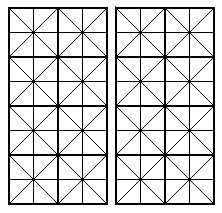
|
Everyone comes to Rick's.
Saturday June 21, 2008
for lifetime achievement
in arts and philosophy
this year goes to
Charles Taylor,

Montreal philosophy professor.
“The Kyoto Prize has been given in three domains since 1984:
advanced technology, basic sciences, and the arts and philosophy.
It is administered by the Inamori Foundation, whose president,
Kazuo Inamori, is founder and chairman emeritus of Kyocera and
KDDI Corporation, two Japanese telecommunications giants.”
 |
|
“The Kyocera brand symbol is composed of a corporate mark |
Related material —

Charles Taylor,
“Epiphanies of Modernism,”
Chapter 24 of Sources of the Self
(Cambridge U. Press, 1989, p. 477) —
“… the object sets up
a kind of frame or space or field
within which there can be epiphany.”
See also Talking of Michelangelo.
Friday, June 20, 2008
Friday June 20, 2008
who died on Tuesday, June 17, 2008
"A man walks down the street…" — Paul Simon, Graceland album

Related material:
In the above screenshot of New York Times obituaries on the date of Brewster Beach's death, Tim Russert seems to be looking at the obituary of Air Force Academy chapel architect Walter Netsch. This suggests another chapel, more closely related to my own experience, in Cuernavaca, Mexico. Some background… Walter Netsch in Oral History (pdf, 467 pp.):
"I also had a book that inspired me– this is 1947– called Communitas by Percival and Paul Goodman. Percival Goodman was the architect, and Paul Goodman was the writer and leftist. And this came out of the University of Chicago– part of the leftist bit of the University of Chicago…. I had sort of in the back of my mind, Communitas appeared from my subconscious of the new town out of town, and there were other people who knew of it…."
"God As Trauma" by Brewster Yale Beach:
"The problem of crucifixion is the beginning of individuation."
"Si me de veras quieres, deja me en paz."
— Lucero Hernandez, Cuernavaca, 1962
A more impersonal approach to my own drunkard's walk (Cuernavaca, 1962,
after reading the above words): Cognitive Blending and the Two Cultures
An approach from the culture (more precisely, the alternate religion) of Scientism–
The Drunkard's Walk: How Randomness Rules Our Lives— is sketched
in Today's Sermon: The Holy Trinity vs. The New York Times (Sunday, June 8, 2008).
The Times illustrated its review of The Drunkard's Walk with facetious drawings
by Jessica Hagy, who uses Venn diagrams to make cynical jokes.
A less cynical use of a Venn diagram:

Thursday, June 19, 2008
Thursday June 19, 2008
“The soul of the commonest object,
the structure of which is so adjusted,
seems to us radiant. The object
achieves its epiphany.”

Above: Screenshot of today’s
New York Times obituary for
mathematician Detlef Gromoll,
known for the “soul theorem.”
Gromoll died on May 31
according to his son
Hans Christian.
From his obituary:
“Detlef Gromoll was born in Berlin
in 1938, and his childhood
was disrupted by the falling
bombs of World War II.”
Related material:
The discussion here
on June 1 of a lottery number
from the date of Gromoll’s death,
childhood, mathematics,
and prewar Berlin.
Wednesday, June 18, 2008
Wednesday June 18, 2008
| CHANGE FEW CAN BELIEVE IN |
Page 67 —
“… Bill and Violet were married. The wedding was held in the Bowery loft on June 16th, the same day Joyce’s Jewish Ulysses had wandered around Dublin. A few minutes before the exchange of vows, I noted that Violet’s last name, Blom, was only an o away from Bloom, and that meaningless link led me to reflect on Bill’s name, Wechsler, which carries the German root for change, changing, and making change. Blooming and changing, I thought.”
For Hustvedt’s discussion of Wechsler’s art– sculptured cubes, which she calls “tightly orchestrated semantic bombs” (p. 169)– see Log24, May 25, 2008.
(after David Wechsler,
1896-1981, chief
psychologist at Bellevue)

These cubes are used to
make 3×3 patterns for
psychological testing.
Related 3×3 patterns appear
in “nine-patch” quilt blocks
and in the following–
| Don Park at docuverse.com, Jan. 19, 2007: “How to draw an Identicon
A 9-block is a small quilt using only 3 types of patches, out of 16 available, in 9 positions. Using the identicon code, 3 patches are selected: one for center position, one for 4 sides, and one for 4 corners. Positions and Rotations For center position, only a symmetric patch is selected (patch 1, 5, 9, and 16). For corner and side positions, patch is rotated by 90 degree moving clock-wise starting from top-left position and top position respectively.” |
| From a weblog by Scott Sherrill-Mix:
“… Don Park came up with the original idea for representing users with geometric shapes….” Claire | 20-Dec-07 at 9:35 pm | Permalink “This reminds me of a flash demo by Jarred Tarbell |
| Jared Tarbell at levitated.net, May 15, 2002:
“The nine block is a common design pattern among quilters. Its construction methods and primitive building shapes are simple, yet produce millions of interesting variations.  Figure A. Four 9 block patterns,
arbitrarily assembled, show the grid composition of the block. Each block is composed of 9 squares, arranged in a 3 x 3 grid. Each square is composed of one of 16 primitive shapes. Shapes are arranged such that the block is radially symmetric. Color is modified and assigned arbitrarily to each new block.
The basic building blocks of the nine block are limited to 16 unique geometric shapes. Each shape is allowed to rotate in 90 degree increments. Only 4 shapes are allowed in the center position to maintain radial symmetry.
 Figure B. The 16 possible shapes allowed |
Such designs become of mathematical interest when their size is increased slightly, from square arrays of nine blocks to square arrays of sixteen. See Block Designs in Art and Mathematics.
(This entry was suggested by examples of 4×4 Identicons in use at Secret Blogging Seminar.)
Tuesday, June 17, 2008
Tuesday June 17, 2008
"History, Stephen said,
is a nightmare from which
I am trying to awake."
— Ulysses
|
When? Going to dark bed there was a square round Sinbad the Sailor roc's auk's egg in the night of the bed of all the auks of the rocs of Darkinbad the Brightdayler. Where?
— Ulysses, conclusion of Chapter 17 |
|
His manner was all charm and grace; pure cafe society…. He purred a chuckle. "Love to. The Luogo Nero? "That's what the locals call it.
— Psychoshop, by |
In memory of
special effects wizard
Stan Winston,
who died Sunday at 62:

"The energetic Winston
was always looking
to the next project."
— Today's LA Times,
story by
Dennis McLellan
Monday, June 16, 2008
Monday June 16, 2008
(American Mathematical Society Feb. 2008
review of Steven Brams’s Superior Beings:
If They Exist, How Would We Know?)
(pdf, 15 megabytes)
"Brams does not attempt to prove or disprove God. He uses elementary ideas from game theory to create situations between a Person (P) and God (Supreme Being, SB) and discusses how each reacts to the other in these model scenarios….
1) P can believe in SB's existence
2) P can not believe in SB's existence
The Supreme Being also has two options:
1) SB can reveal Himself
2) SB can not reveal Himself
Each player also has a primary and secondary goal. For the Person, the primary goal is to have his belief (or non-belief) confirmed by evidence (or lack thereof). The secondary goal is to 'prefer to believe in SB’s existence.' For the Supreme Being, the primary goal is to have P believe in His existence, while the secondary goal is to not reveal Himself. These goals allow us to rank all the outcomes for each player from best (4) to worst (1). We end up with a matrix as follows (the first number in the parentheses represents the SB's ranking for that box; the second number represents P's ranking):

Analogously:
|
Lotteries on Bloomsday, June 16, 2008 |
Pennsylvania (No revelation) |
New York (Revelation) |
|
Mid-day (No belief) |
418
No belief, |
064
Revelation |
|
Evening (Belief) |
709
Belief without |
198
|
The holy image

denoting belief and revelation
may be interpreted as
a black hole or as a
symbol by James Joyce:
|
When? Going to dark bed there was a square round Sinbad the Sailor roc's auk's egg in the night of the bed of all the auks of the rocs of Darkinbad the Brightdayler. Where?
— Ulysses, conclusion of Chapter 17 |
Sunday, June 15, 2008
Sunday June 15, 2008
I want a shot at redemption.
Don’t want to end up a cartoon
In a cartoon graveyard.”
— Paul Simon
Sunday June 15, 2008
A Cartoon Graveyard
Click to enlarge.

From Fathers' Day Meditation:
For further details,
click on the well.
Saturday, June 14, 2008
Saturday June 14, 2008
An online tribute to Tim Russert
this morning had a song by a
Russert favorite, Bruce Springsteen:
Hard Lessons

and the
five Log24 entries
ending on July 20, 2006,
which contain the following
example of what might be
caled "sacred order"
(see yesterday's entries)–

See also "Grave Matters" here
on November 8, 2006, and
the same date four years earlier,
as well as
"O Grave, Where Is Thy Victory?"
(pdf), a lecture by Jack Miles
at Clark Art Institute
(see Oct. 7-9, 2002)
on November 9, 2002.
The Miles lecture may be of
more comfort to Russert's
mourners than the
cross/wheel symbolism,
which has its dark side.
The cross, the wheel,
the Catholic faith, and
Russert's field of expertise,
politics, are of course
notably combined in the
crux gammata, discussed
here in a 2002 entry on
the Triumph of the Cross
and the Death of Grace
(Princess of Monaco).
Friday, June 13, 2008
Friday June 13, 2008
Edward Rothstein last Monday:
"What is being said?
What does it mean?
Where does it come from
and where else is it used?"
A partial answer:
today's previous entry,
"For Philip Rieff,"
and an midrash on
the word "Pahuk"
(as in "Pahuk Pride,"
the name of this week's
Boy Scout gathering
in Iowa at which
a tornado killed four) —

Click on image for further details.
Rieff was the author of
Sacred Order/Social Order,
Volume 1–
My Life among the Deathworks:
Illustrations of the
Aesthetics of Authority
(University of Virginia Press, 2006)
Rieff's concept of sacred order
was Jewish rather than Pawnee,
but his writings still seem relevant.
Friday June 13, 2008
In Lieu of
Stained Glass
"Examples are the stained-
glass windows of knowledge."
— Vladimir Nabokov,
quoted here last Monday
in "Interpret This"
Illustration by Jessica Hagy
from "Today's Sermon"
last Sunday:
Application Form for
the Worst Camping Trip Ever:
(Click here for original pdf.)
PAHUK PRIDE – 2008
YOUTH LEADERSHIP
TRAINING CONFERENCE
MID-AMERICA COUNCIL –
LITTLE SIOUX SCOUT RANCH
PARTICIPANT REGISTRATION
————————————–
THANK YOU FOR PRINTING
ALL INFORMATION LEGIBLY!!
* Former husband of Susan Sontag
and author of
My Life Among the Deathworks
Thursday, June 12, 2008
Thursday June 12, 2008
for the staff of
The New York Times:
Eyewitness accounts of
Scout Camp tornado
that killed four
(continued from
Today’s Sermon,
Sunday, June 8)
Related material:
Log24 entry of
one year ago today —
On Framing Science —
Frame this.
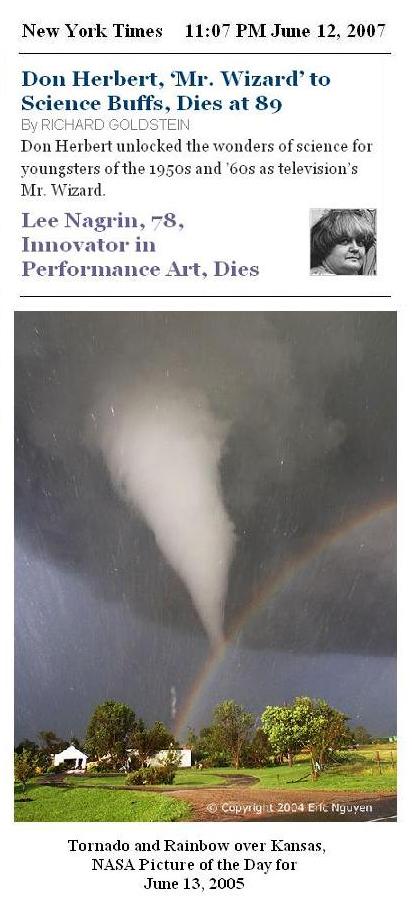
See also the four previous entries.
Thursday June 12, 2008

“The scientific mind does not so much
provide the right answers as
ask the right questions.”
(The Raw and the Cooked,
1964, English translation 1969 —
paperback, U. of Chicago Press,
1983, “Overture,” p. 7)

Context of the question:
A Venn diagram —
shown here last Sunday —
by the illustrator of last Sunday’s
New York Times review of
The Drunkard’s Walk:
How Randomness
Rules Our Lives
Well, do you?

Related material:
6/10
(San Francisco’s new
Contemporary Jewish Museum
as a vision of Hell)
9/28
(A less theological,
more personal, discussion
of Venn diagrams)
Wednesday, June 11, 2008
Wednesday June 11, 2008
Indiana Jones and the
Worst Camping Trip Ever
Part I:
“Today’s Sermon”
from last Sunday —
The Holy Trinity vs.
The New York Times —
| http://indexed.blogspot.com/
Thursday, February 15, 2007 Posted by Jessica Hagy at 10:31 PM |
Part II:
Today’s previous entries

Part III:

Susan Sontag,
Notes on “Camp”
Wednesday June 11, 2008
vs. the Alphabet
in today’s New York Times:

(continued from
Einstein’s birthday, 2003)
Links from the above image:
The Painter and Letters
Wednesday June 11, 2008
Amazon Delivery
Click on images for details.
Related material:
Wednesday June 11, 2008
Asinof married Jocelyn Brando, the sister of actor Marlon Brando, after meeting when she was appearing on Broadway.
Tuesday, June 10, 2008
Tuesday June 10, 2008
Return to Paradise
Edward Rothstein's review in yesterday's New York Times–
Museum’s Vision:
West Coast Paradise —
seems to me more a description of Hell.
My own concept of paradise is closer to the Gary Cooper film "Return to Paradise," which impressed me greatly when I saw it on TV when I was in 10th grade.
A related vision: two frames from the Jodie Foster film "Contact"–

|

|
See Storyline and Time Fold.
See also another Michener-based
production, the current
Lincoln Center "South Pacific."
Monday, June 9, 2008
Monday June 9, 2008
Readers of the previous entry
who wish to practice their pardes
may contemplate the following:

The evening 563 may, as in other recent entries, be interpreted as a page number in Gravity’s Rainbow (Penguin Classics, 1995). From that page:
‘What’s it mean?’
[….]
Slothrop gives him the mandala. He hopes it will work like the mantra that Enzian told him once, mba-kayere (I am passed over), mba-kayere… a spell […]. A mezuzah. Safe passage through a bad night….”
Christ and the Four Elements
This 1495 image is found in
The Janus Faces of Genius:
The Role of Alchemy
in Newton’s Thought,
by B. J. T. Dobbs,
Cambridge University Press,
2002, p. 85
Related mandalas:
and
For further details,
click on any of the
three mandalas above.
“For every kind of vampire,
there is a kind of cross.”
— Thomas Pynchon, quoted
here on 9/13, 2007
Time of entry: 10:20:55 PM
Monday June 9, 2008
Interpret This
"With respect, you only interpret."
"Countries have gone to war
after misinterpreting one another."
it must have been a revolutionary
and creative move to design works
of art so that they might be
experienced on several levels."
— Susan Sontag,
"Against Interpretation"
"An introductory wall panel tells us that in the Jewish mystical tradition the four letters [in Hebrew] of pardes each stand for a level of biblical interpretation: very roughly, the literal, the allusive, the allegorical and the hidden. Pardes, we are told, became the museum’s symbol because it reflected the museum’s intention to cultivate different levels of interpretation: 'to create an environment for exploring multiple perspectives, encouraging open-mindedness' and 'acknowledging diverse backgrounds.' Pardes is treated as a form of mystical multiculturalism.
But even the most elaborate interpretations of a text or tradition require more rigor and must begin with the literal. What is being said? What does it mean? Where does it come from and where else is it used? Yet those are the types of questions– fundamental ones– that are not being asked or examined […].
How can multiple perspectives and open-mindedness and diverse backgrounds be celebrated without a grounding in knowledge, without history, detail, object and belief?"
How the data arrange
themselves inside it."
"Examples are the stained-
glass windows of knowledge."
Click on image to enlarge.
Sunday, June 8, 2008
Sunday June 8, 2008
The New York Times
From the illustrator of
today's NY Times review of
The Drunkard's Walk —
|
http://indexed.blogspot.com/
Thursday, February 15, 2007
Posted by Jessica Hagy at 10:31 PM |
The book under review–
The Drunkard's Walk:
How Randomness Rules Our Lives,
by the author of Euclid's Window—
is, appropriately, published by
Random House:
Click image for
related material.
Sunday June 8, 2008
| CHANGE TO BELIEVE IN |
Part I:

Part II:

16
|
Thus the ancient kings made music
In order to honor merit, And offered it with splendor To the Supreme Deity, Inviting their ancestors to be present. When, at the beginning of summer, thunder– electrical energy– comes rushing forth from the earth again, and the first thunderstorm refreshes nature, a prolonged state of tension is resolved. Joy and relief make themselves felt. So too, music has power to ease tension within the heart and to loosen the grip of obscure emotions. The enthusiasm of the heart expresses itself involuntarily in a burst of song, in dance and rhythmic movement of the body. From immemorial times the inspiring effect of the invisible sound that moves all hearts, and draws them together, has mystified mankind. Rulers have made use of this natural taste for music; they elevated and regulated it. Music was looked upon as something serious and holy, designed to purify the feelings of men. It fell to music to glorify the virtues of heroes and thus to construct a bridge to the world of the unseen. In the temple men drew near to God with music and pantomimes (out of this later the theater developed). Religious feeling for the Creator of the world was united with the most sacred of human feelings, that of reverence for the ancestors. The ancestors were invited to these divine services as guests of the Ruler of Heaven and as representatives of humanity in the higher regions. This uniting of the human past with the Divinity in solemn moments of religious inspiration established the bond between God and man. The ruler who revered the Divinity in revering his ancestors became thereby the Son of Heaven, in whom the heavenly and the earthly world met in mystical contact. These ideas are the final summation of Chinese culture. Confucius has said of the great sacrifice at which these rites were performed: "He who could wholly comprehend this sacrifice could rule the world as though it were spinning on his hand." |
Saturday, June 7, 2008
Saturday June 7, 2008
“At the still point,
there the dance is.”
— T. S. Eliot,
quoted here in the entry
of 2:45 AM Friday
In memory of
Eugenio Montejo,
Venezuelan poet who
died at around midnight
on Thursday night:
From an obituary:
In one scene, Sean Penn’s character quoted a line from a 1988 poem by Montejo. It reads: ‘The earth turned to bring us closer. It turned on itself and in us, until it finally brought us together in this dream.'”
Related material:
A link in the entry of
2:45 AM Friday to
“The Cha-Cha-Cha Theory
of Scientific Discovery”
and a news story from the
Cannes Film Festival
dated May 18, 2007,
that features Inarritu:
Friday, June 6, 2008
Friday June 6, 2008

Midrash:
The Dance of Chance
Associated Press
"Today in History"
Thought for Today:
"Two dangers constantly threaten
the world: order and disorder."
— Paul Valery, French poet
(1871-1945).
[La Crise de l'Esprit]
Also from Valéry:
«Notre esprit est fait d'un désordre,
plus un besoin de mettre en ordre.»
(Mauvaises Pensées et Autres)
«L’ordre pèse toujours à l’individu. Le désordre lui fait désirer la police ou la mort. Ce sont deux circonstances extrêmes où la nature humaine n’est pas à l’aise. L’individu recherche une époque tout agréable, où il soit le plus libre et le plus aidé. Il la trouve vers le commencement de la fin d’un système social. Alors, entre l’ordre et le désordre, règne un moment délicieux. Tout le bien possible que procure l’arrangement des pouvoirs et des devoirs étant acquis, c’est maintenant que l’on peut jouir des premiers relâchements de ce système. Les institutions tiennent encore. Elles sont grandes et imposantes. Mais sans que rien de visible soit altéré en elles, elles n’ont guère plus que cette belle présence; leurs vertus se sont toutes produites; leur avenir est secrètement épuisé; leur caractère n’est plus sacré, ou bien il n’est plus que sacré; la critique et le mépris les exténuent et les vident de toute valeur prochaine. Le corps social perd doucement son lendemain. C’est l’heure de la jouissance et de la consommation générale.»
— Paul Valéry, Préface aux Lettres Persanes (1926), recueillie dans Variété, II, 1930
Friday June 6, 2008
"Harvard seniors have
every right to demand a
Harvard-calibre speaker."
— Adam Goldenberg in
The Harvard Crimson
"Look down now, Cotton Mather"
— Wallace Stevens,
Harvard College
Class of 1901
For Thursday, June 5, 2008,
commencement day for Harvard's
Class of 2008, here are the
Pennsylvania Lottery numbers:
Mid-day 025
Evening 761
Thanks to the late
Harvard professor
Willard Van Orman Quine,
the mid-day number 025
suggests the name
"Isaac Newton."
(For the logic of this suggestion,
see On Linguistic Creation
and Raiders of the Lost Matrix.)
Thanks to Google search, the
name of Newton, combined with
Thursday's evening number 761,
suggests the following essay:
PHILOSOPHY OF SCIENCE:
|
What can a non-scientist add?
Perhaps the Log24 entries for
the date of Koshland's death:
The Philosopher's Stone
and The Rock.
Or perhaps the following
observations:
On the figure of 25 parts
discussed in
"On Linguistic Creation"–
"The Moslems thought of the
central 1 as being symbolic
of the unity of Allah. "
— Clifford Pickover
"At the still point,
there the dance is."
— T. S. Eliot,
Harvard College
Class of 1910
Tuesday, June 3, 2008
Tuesday June 3, 2008
and The New Yorker
On Faith:
Among the varieties of Christian monotheism, none is more totalitarian, none lodges more radical claims for God's omnipotence, than Calvinism– and within America, the chief analogue of Calvinist theology, Puritanism. According to Calvin every particle of dust, every act, every thought, every creature is governed by the will of God, and yields clues to the divine plan."
On Doubt:
"a Puritan reflex of seeking other orders beyond the visible, also known as paranoia"
— Thomas Pynchon, Gravity's Rainbow (Penguin Classics, 1995), p. 188
On Art:
I suggest that faith and doubt are best reconciled by art– as in A Contrapuntal Theme and in the magazine's current online podcast of Mary Gaitskill reading a 1948 New Yorker story by Vladimir Nabokov.
For the text of the story, see "Signs and Symbols." For an excellent discussion of Nabokov's art, see "The Signs and Symbols in Nabokov's 'Signs and Symbols,'" by Alexander Dolinin.
Sunday, June 1, 2008
Sunday June 1, 2008
Cartoon Graveyard
The conclusion of yesterday’s commentary on the May 30-31 Pennsylvania Lottery numbers:
Thomas Pynchon, Gravity’s Rainbow:
“The fear balloons again inside his brain. It will not be kept down with a simple Fuck You…. A smell, a forbidden room, at the bottom edge of his memory. He can’t see it, can’t make it out. Doesn’t want to. It is allied with the Worst Thing.
He knows what the smell has to be: though according to these papers it would have been too early for it, though he has never come across any of the stuff among the daytime coordinates of his life, still, down here, back here in the warm dark, among early shapes where the clocks and calendars don’t mean too much, he knows that’s what haunting him now will prove to be the smell of Imipolex G.
Then there’s this recent dream he is afraid of having again. He was in his old room, back home. A summer afternoon of lilacs and bees and
286”
What are we to make of this enigmatic 286? (No fair peeking at page 287.)
One possible meaning, given The Archivist‘s claim that “existence is infinitely cross-referenced”–
Page 286 of Ernest G. Schachtel, Metamorphosis: On the Conflict of Human Development and the Psychology of Creativity (first published in 1959), Hillsdale NJ and London, The Analytic Press, 2001 (chapter– “On Memory and Childhood Amnesia”):
“Both Freud and Proust speak of the autobiographical [my italics] memory, and it is only with regard to this memory that the striking phenomenon of childhood amnesia and the less obvious difficulty of recovering any past experience may be observed.”
The concluding “summer afternoon of lilacs and bees” suggests that 286 may also be a chance allusion to the golden afternoon of Disney’s Alice in Wonderland. (Cf. St. Sarah’s Day, 2008)
Some may find the Disney afternoon charming; others may see it as yet another of Paul Simon’s dreaded cartoon graveyards.
More tastefully, there is poem 286 in the 1919 Oxford Book of English Verse– “Love.”
For a midrash on this poem, see Simone Weil, who became acquainted with the poem by chance:
“I always prefer saying chance rather than Providence.”
— Simone Weil, letter of about May 15, 1942
Weil’s brother André might prefer Providence (source of the Bulletin of the American Mathematical Society.)
 (Photo from Providence)
(Photo from Providence)
White, Geometric, and Eternal—
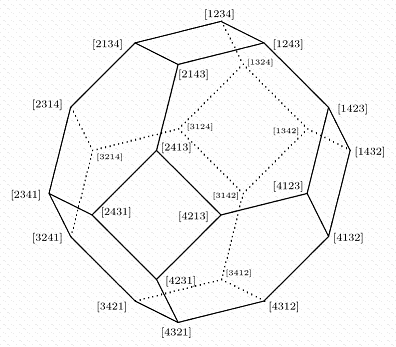
For more on the mathematical significance of this figure, see (for instance) Happy Birthday, Hassler Whitney, and Combinatorics of Coxeter Groups, by Anders Björner and Francesco Brenti, Graduate Texts in Mathematics, vol. 231, Springer, New York, 2005.
This book is reviewed in the current issue (July 2008) of the above-mentioned Providence Bulletin.
The review in the Bulletin discusses reflection groups in continuous spaces.
the phrase “as a little child.”




